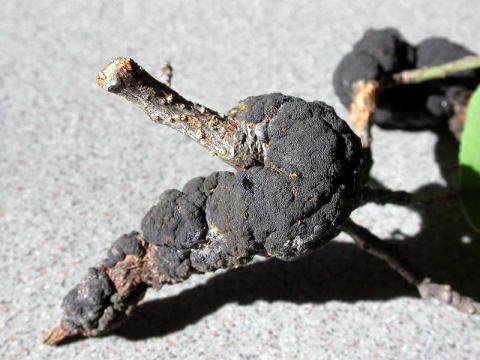My plum tree has black fungus growing on the branches. What can I do to treat it?

Trees in the genus Prunus, which includes plum, are susceptible to a fungal disease called black knot. Trees infected with black knot have swollen, hard, black knots on their branches. The disease is common on both wild and landscape trees and is easily diagnosed by the swollen, black galls that appear on infected branches. The fungus produces spores in the spring and early summer that are dispersed by splashing or windblown rain. When the spores land on the branches of susceptible trees, they enter straight through the bark on the current season’s growth or through wounds. Infected branches gradually swell throughout the growing season, progressively growing into obvious hard, black knots by the fall. The knots, which can grow to over six inches long, will continue to enlarge until they girdle the affected branches. The fungus overwinters in the knots on the stem, beginning growth again in the spring and producing more spores to start the disease cycle all over again.
Control of black knot requires both prevention and sanitation. Prune out all infected branches in late winter (late February through the end of March) and destroy them by burning, burying, or throwing them away. Remove at least 3-4 inches of healthy tissue below each knot to ensure elimination of the fungus. Heavily infected trees should be removed completely, including wild host trees such as black cherry (Prunus serotina). However, the most effective way to avoid issues with black knot in the future is to plant resistant varieties of plum.
This was your Question of the Week. Got questions? The Ask UNH Extension Infoline offers practical help finding answers for your home, yard, and garden questions. Call toll free at 1-877-398-4769, Monday to Friday, 9 a.m. to 2 p.m., or e-mail us at answers@unh.edu.